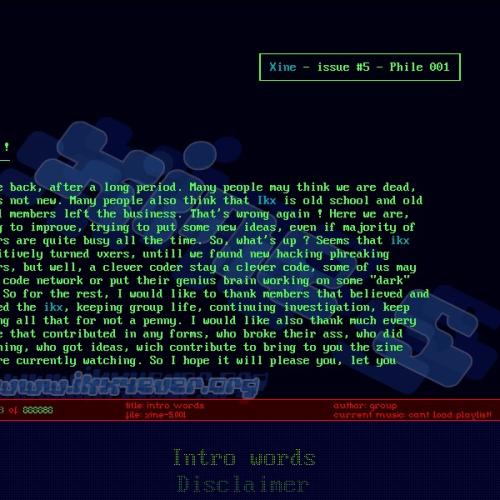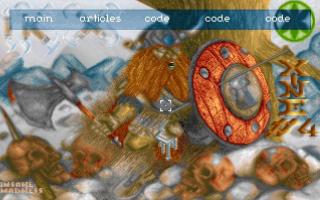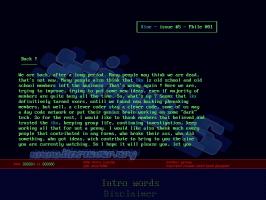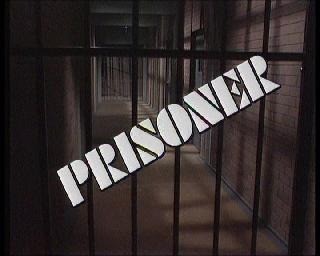Copy Link
Add to Bookmark
Report
xine-2.013

/-----------------------------\
| Xine - issue #2 - Phile 013 |
\-----------------------------/
____________________________
\TBAV CRC files demystified/
\ b0z0/iKx /
\______________________/
0) First of all :)
------------------
With this small txt i would like to demostrate how exactly (well, i'll try
to do the best ;) ) TBAV (yea, i know that TBAV is the entire package and the
part for CRCs is TBSetup, but i'll refeer in the text to the CRC generator
with any name i can come out :) ) creates the CRC files.
Untill today generally retro viruses quite always simply deleted the
CRC files (chmod + unlink) indifferently at any virus infection if a CRC
file was present in the directory. As you will notice if you continue reading
deleting is maybe the simplest and fastest way to do the dirty work, but on
the other side it isn't very polite and professional :) So with this small
doc i would like to try to open your eyes to new frontiers of retro actions
and armor features against CRC files.
If you are in a hurry or if you aren't interested in the exact form of the
ANTI-VIR.DAT (it may seems boring and stupid, but i must say that it can
bring you some really interesting ideas for future tricks and
implementations) skip the first part and go to part 2 (section "So what?")
and to part 3 where you will find some interesting tricks.
This text and all it's code is based on TBAV 7.07 but it has been
succesfully tested also on versions 7.06, 7.05 and also on versions
6.05, 6.12 ,6.34 and also (rumble rumble :) ) on TBAV 5.01!
I suppose that the TBAV CRC file format has remained unchanged (except
for an encryption value of which we will talk later) from version 5.xx
(or maybe from an older one :) but i don't have older ones! Frans please
send some ;-) ).
1) Format of ANTI-VIR.DAT:
--------------------------
The ANTI-VIR.DAT has at the start a 80h bytes long header, where copyright
notice and so on is stored. Apart from this stuff at offset 56h there is an
important word, that is used for the encryption of the various CRC data
(on all 7.x versions the value seems to be 1992h, on the 6.34 is for example
197Ah, on 6.11 is 1936h but anyway we will just read it from here ;)).
After the 80h bytes there are 40h bytes of data for every file (executable
of course) that is present in the current directory. And now here we are at
the interesting infos :)
The first 12d bytes are reserved for the filename and extension of the file
of that block. The filename of the file is always unencrypted, so as you
may have already noticed you can see it with a normal file viewer ;) If the
filename+extension is shorter than 12d bytes then the remaining bytes will
be filled with zeros.
All the informations about the file that TBAV stores after the filename
(from byte 0Ch to 20h of the file entry) are encrypted. The encryption of
this is rather simple. Let's look finally at some source ;)
;
; It is assumed that DI points to space where ANTI-VIR.DAT was readed to
; (so at DI you will see the TBAV message and so on... so we will be able
; to get the decryption value from DI+56h).
; It is assumed that SI points to encrypted part of the file entry in
; ANTI-VIR.DAT that we are going to decrypt. (that is after the undecrypted
; filename).
;
; This routine will decrypt the contents and will put the decrypted bytes
; in the same place where we readed them from.
;
mov dx,1ah ; words to decrypt
mov cx,word ptr ds:[di+56h] ; decryption value from the
; header at offset 56h
xor cx,word ptr ds:[si-0Ch] ; xor the encryption value
; with the first word of
; the filename
decrypt_loop:
mov ch,cl
dec cx ; action on key
and cl,0fh
mov ax,word ptr ds:[si] ; get a word to decrypt
xor ax,cx
rol ax,cl ; decryption stage
sub ax,cx
xor ax,word ptr ds:[di+56h]
mov word ptr ds:[si],ax ; store decrypted
inc si
inc si ; point to next word
dec dx ; dec counter
jnz decrypt_loop
As you may see it is quite simple, just a couple of math operations (xor,
rol, sub, xor). Nothing special, really, but after this decryption we will
have a bounch of interesting informations. Let's see...
Further the offsets will be intended as refeering from the start of the
file entry. So for example 00h is the first letter of the filename and
0Bh is the last space for filename and extension. So:
Offset 0Ch - here we find a word that contains the low part of the
file lenght. The second part (the high word) is founded
at offset 36h. Of course if the file is a COM file the
entire lenght will be as a word in this place.
Offset 0Eh - from offset 0Eh up to offset 2Dh TBAV will store the first
20h bytes of the file. As you may fastly notice TBAV
will be able to reconstruct an infected file only if the
changes are in the first 20h bytes.
Offset 2Eh - here we find one part of the checksum (the DX result one).
The checksum algorithm will be explained later.
Offset 30h - from offset 30h up to offset 35h TBAV will store six bytes
from the real (or more probable) entry point of the file.
If the file is an .EXE then TBAV will calculate the entry
point from the header (cs,ip,header lenght) and then store
6 bytes here starting from the calculated lenght. If the
file is a COM then TBAV will check the first byte of the
file. If this byte is equal to 0E8h (CALL), to 0E9h (a JMP)
or to 0EBh (a JMP SHORT) then TBAV will save the 6 bytes
that are pointed from this instructions (of course it will
look the word (or byte) after one of this bytes, this is
the offset of the jump). If the first byte of the COM isn't
equal to 0E9h,0E8h or 0EBh this six bytes will be set to
zero.
Offset 36h - contains the high word of the lenght. Combining this to
the word at offset 0Ch you'll get the lenght of the file.
Of course if the file is a COM this will be zero.
Offset 38h - here we find another part of the checksum (AX value).
The checksum algorithm will be explained later.
Offset 3Ah - contains a word with the flags for the file. This refeers
to the suspicious flags issued by TBScan for some normal
files. Get a look to TBSETUP.DAT. For example MSCDEX.EXE
(which is normally a good file) has this flags set to
0011h (as documented). Of course TBAV does just a name
check, not a more detailed check. So is you rename MSCDEX.EXE
the flags won't be there. Also for the meaning of the
various bits in this word give a look to TBSETUP.DAT intro.
Offset 3Ch - always a zero word.
Offset 3Eh - contains a validation value for this file entry. So TBAV
will be able to say if someone changed the CRC file without
recalculating this value. The routine for doing this will
be explained later.
Checksum Calculation
--------------------
The checksum that TBAV calculates and stores as two words on 2Eh and 38h
is done on the _entire_ file. TBAV specifically does this by chunks of 8000h
bytes, but you may do this as you like.
;
; It is assumed that AX and DX contains the CRC value of the previous block.
; For the first block of course the values will be AX=0 and DX=0. As you may
; see the routine isn't dependant by the block lenght, since AX and DX are
; carryed from the previous block unmodified.
; We suppose also that DS:SI points to the buffer where the file (or a part
; of the file, this is a block) is situated. Of course before you have to
; open it, read and so on...
;
mov di,cx ; CX = lenght of this block.
; of course this may be a value from
; 1 up to 8000.
shr di,1 ; how many words
startit:
test ah,80h
jz krad1
xor ax,0A097h
krad1:
test dh,80h
jz krad2
xor dx,0A097h
krad2:
mov bx,ax
add bx,ax
mov cx,dx
add cx,dx
lodsw ; get a word from file buffer
mov dl,ah
add ax,bx
mov ah,bh ; do the work
add dx,cx
mov dh,ch
dec di ; dec counter
jnz startit
;
; On exit DX and AX carryes the calculated value that will be used in the
; next loop or, when the entire file will be passed, will be stored at
; offset 2Eh and 38h
;
Validation Calculation
----------------------
To prevent a fast and simple modification of the data in a ANTI-VIR.DAT
entry TBAV creates also a validation value for each entry, so when TBClean
is run it will first of all try to determinate if the entry in ANTI-VIR.DAT
is corrupted by doing the calculation in the reverse order as it was done
when created. This validation is done of course on the decrypted data. The
validation word is also encrypted with the same loop as other data.
This validation is very simple and is based on the contents of the first
03Eh bytes of the just created ANTI-VIR.DAT data (i mean the decrypted
one). Let's see some source:
;
; Assuming SI points to the start of the file entry in ANTI-VIR.DAT (this
; is at offset 00h, on the first letter of the filename)
;
xor ax,ax ; clear value
mov cx,03eh ; how many bytes we will calculate,
; this is the lenght of the file
; entry minus one word for this
; check
pkt_loop:
add ax,ax
add al,byte ptr ds:[si] ; the main routine
inc si
do_the_xor:
xor ax,0a097h
js do_the_xor
loop pkt_loop
At the end we will find in AX the value for the validation of this entry
in the ANTI-VIR.DAT file.
Entry encryption
----------------
Well, as we have decrypted it we must also encrypt it at the end. The
way is the same, just start from the other end ;) Want code? Get code...
;
; As before: SI points on offset 0Ch of our entry (that which will be
; encrypted). DI points on the start of ANTI-VIR.DAT in memory.
;
mov dx,1ah ; words to encrypt
mov cx,word ptr ds:[di+56h] ; decryption value from the
; header at offset 56h
xor cx,word ptr ds:[si-0Ch] ; xor the encryption value
; with the first word of
; the filename
encrypt_loop:
mov ch,cl
dec cx ; modify key as needed
and cl,0fh
mov ax,word ptr ds:[si] ; get a word
xor ax,word ptr ds:[di+56h]
add ax,cx
ror ax,cl ; do the operations in the reverse
xor ax,cx ; order as for decryption
mov word ptr ds:[si],ax ; store it there
inc si ; on next word
inc si
dec dx ; dec counter
jnz encrypt_loop
Entry Point data
----------------
The rest of bytes as i said in the entry are the first 20h bytes (well,
i won't tell you how to get them, heh ;) ) and the 6 entry point bytes
(if present). As for the entry point the things aren't really difficoult
to do. TBAV just gets the offset (+03h) after the jump (call...) for COMs
and calculates the place in the file using CS:IP and header lenght for
EXEs. TBAV will do this in the middle of the CRC routine (of course to make
the calculation of the data a little faster), but there isn't really anything
so difficoult and you can figure out yourself how it is done ;)
CRC File creation
-----------------
It is also interesting how TBAV (Tbsetup) looks and reads for/from files
when needed. To get the list of the avaiable executables in the directory
TBAV will simply use the classic 4Eh/4Fh (findfirst/findnext). Searched
files are .EXE, .COM, .SYS and .BIN (wtf are you searching BINs Frans? ;) )
Once TBAV has found one suitable file it will open it with the normal DOS
Open int21h call. It will just use int 21h with 3D40h (AH=3D open file,
AL=40h=01000000 means readonly and for sharing allow full access by others).
Also the read/close are the most standard ones (3Fh and 3Eh).
2) So what?
-----------
As i already said the classic and most used method is deleting CRC files
at each succesfull infection. Yea, this is the fastest, easyest and shortest
method, but the user may notice that TBSetup is adding the same files in
the directory a little too often :) What can we do? Lets see:
Ask TBSetup to work for you
---------------------------
Since, as i explained before, TBAV uses normal DOS Open (AH=3D) we may just
hook this option and when TBSetup will calculate its data it will at the
same time it will infect all the files with our virus (and will also put
the right checksum, lenght and so on... heheheh). So we may infect always
on 3Dh or if you like you may turn the virus to a fast-infector when
TBSetup is run. The only problem is that TBAV gets the lenght of the file
from the DTA block of the previous findfirst/findnext session. Definitely
we must also hook findfirst 4Eh and 4Fh. You may then select if directly
infecting on 4Eh and 4Fh or you may infect on 3Dh and just modify the lenght
in the DTA with the other 4Eh/4Fh hook. That's up to you. You may opt to
make with the 4Eh/4Fh just the size increase and with 3Dh the infection,
so you will also be able to infect correctly when PKZIP is run (more about
this in VLAD7).
Of course there is just a little problem: what to do if the ANTI-VIR.DAT
is already present in the directory? Of course we must delete it, but when?
If the CRC file contains the CRCs with our virus and so on we don't want to
delete it, we want to delete it just when the original contents are still
there.
This is rather simple to do, here are some suggestion:
- Delete the ANTI-VIR.DAT at the first time just before TBSetup is runned.
Of course then mark that you already deleted it in this directory
somewhere (for example you may set a special time or attribute to
the ANTI-VIR.DAT file when it will be written or you may put a mark
to its directory entry). Of course if you do this you must then infect
*all* the executable files in the directory so the right infected CRCs
will be calculated and stored. So when TBSetup is being runned (hook on
exec - 4Bh):
+ If mark (put it where you want ;) ) is present then the ANTI-VIR.DAT
is up to /virus/ date :) So just activate the fast infection, so if
there are some new files (we are sure that all the old ones are really
infected) then they will be infected
+ If not, delete ANTI-VIR.DAT and activate all infection functions
+ At the end of execution set the mark
* This method is quite reailable, fast and easy to implement.
Pay attention that TBSetup by default searches recursively also in the
dirs. So delete the CRC files also in the subdirs or add a "nosub" to the
TBSetup command line.
Help TBSetup
------------
In another way you may just help TBSetup :) When you infected a file you
may check for ANTI-VIR.DAT. If it is present then you may change the
entry for the just infected file, or alternatively you may add a new entry
in the file. The steps are the same, just the pointer where we will write
in ANTI-VIR.DAT is different. So to create your own entry in a buffer:
- Calculate the CRC on the entire infected file and store them to the
right offset in the buffer.
- Copy the new first 20h bytes to the buffer.
- Copy the new 6 entrypoint bytes (the virus head :) )
- Put the lenght in the right offset
- Put the filename+extensions+00h pad bytes
- Calculate the validation value of the newly created entry and put it
as the last word in the entry
- Encrypt the entry starting from offset 0Ch
- Copy (or append) the entry where needed.
This way is quite professional :) The bad news is the implementation. I
done a small proggy (well, that is just a copy/paste of the routines
explained above with some more open/close/read from the files) that may
do this and it took about 400 bytes. Well it was totally _unoptimized_,
but anyway it is maybe a little too long for some coders considering
also that this is TBAV only oriented. But hey, it worked ok ;)
Don't delete it all
-------------------
Instead of deleting the entire CRC file (for example if you have an EXE
infector we don't need to delete also CRCs for COM and SYS files) you may
delete just the entry of the file we have just infected/changed. This is
very simple to do and i am sure that it will decrease the probability of
being noticed. Infact the user may not even notice that TBSetup wrote that
one (or a few) entry has been added, since the scrolling may be quite fast.
On the other side if TBSetup will write the message for all the files in the
directory the user may be warned. Expecially if you have a slow infector
this may be very usefull.
Let's see:
- Find the entry for our file (search for filename) in the ANTI-VIR.DAT.
- If the entry is the last one in the file then just truncate the file
at this position.
- If the entry isn't the last one then copy the last one over the ours,
rewrite the file and truncate the last entry (this is the last 40h bytes)
This is very simple, fast and short. As for an addon feature you may, instead
of hardcoding the lenght of an entry as 40h, check for the entry lenght by
doing a few compares. This will make the code larger, but will guarantee
the compatibility with future versions of TBAV :)
3) "I don't want to change or delete ANTI-VIR.DAT"
--------------------------------------------------
Since not all viruses have to delete/change/do_something with CRC files,
at least *ALL* viruses must do something to try to fool disinfection using
CRC files. We must find some way so the CRC disinfection won't be able to
restore the file.
If you readed the entire text you may now already know what your virus must
do, but anyway here are some notes:
- since TBAV stores just the first 20h bytes of the file (+ the 6 entry
point bytes as i already said) you may just change something out of that
area. For example you may put your infection check somewhere in the middle
or in some specific area of the file (this is very simple for COMs and is
done for example by Sailor_Pluto which put the marker in a random place
in the first 200h bytes. Of course for a better implementation it may
put the check from 20h up to 220h, but that is just a choice of the VW),
or you may encrypt or just excange some bytes of the original file and
restore them just when needed.
As for EXEs you may just check if there is some unused space in the
EXE header (this is very probable... you need just one byte) and if
there is some (you _must_ be sure of this :) ) change just one byte
(or if you like some more ;) ) in there and CRC check/reconstruction
will fail!
- as with the first 20h bytes you may do quite the same (modifications,
encryption or something) on the entry point. Just modify some more bytes
there and TBAV will have a difficoult life ;) For example you may check
if the first byte of the COM file is a jump (call or something) and then
instead of putting (as usual) the jump to your virus from the head you
may put the virus jump (and some more bytes so you will screw the original
6 bytes storage) in the position where the real first victim jump points
to.
- midfile infection. I don't think that more text is needed for this :)
This last section doesn't only apply to TBAV CRC files, but rather generally
to all kind of CRC based systems, since that mainly any of those have a
limited set of saved bytes, so keep an eye on this last section even if you
don't absolutely care about my TBAV CRC file creation method :)
Also this may heavily raise the complexity of the disinfection algorithm if
used in conjunction with a good poly or even with good antidebug/antiemulator
tricks. Even the most carefull user that wastes time to do a CRC on every file
won't be able to survive ];)






















